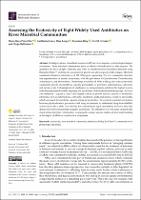Por favor, use este identificador para citar o enlazar este ítem:
https://repositorio.usj.es/handle/123456789/1146
| Título : | Assessing the Ecotoxicity of Eight Widely Used Antibiotics on River Microbial Communities |
| Autor: | Pino Otín, Rosa


Lorca, Guillermo Langa Morales, Elisa 
Roig, Francisco J. 

Terrado, Eva María 
Ballestero Fernández, Diego |
| Palabras clave : | Ecotoxicity; River microbial community; Antibiotics; Biolog EcoPlates™; Community-level; Physiological profiling |
| Fecha de publicación: | 30-nov-2023 |
| Editorial : | MDPI |
| Citación : | Pino-Otín, M.R.; Lorca, G.; Langa, E.; Roig, F.; Terrado, E.M.; Ballestero, D. Assessing the Ecotoxicity of Eight Widely Used Antibiotics on River Microbial Communities. Int. J. Mol. Sci. 2023, 24, 16960. https://doi.org/10.3390/ ijms242316960 |
| Resumen : | Global prevalence of antibiotic residues (ABX) in rivers requires ecotoxicological impact assessment. River microbial communities serve as effective bioindicators for this purpose. We quantified the effects of eight commonly used ABXs on a freshwater river microbial community using Biolog EcoPlates™, enabling the assessment of growth and physiological profile changes. Microbial community characterization involved 16S rRNA gene sequencing. The river community structure was representative of aquatic ecosystems, with the prevalence of Cyanobacteria, Proteobacteria, Actinobacteria, and Bacteroidetes. Our findings reveal that all ABXs at 100 g/mL reduced microbial community growth and metabolic capacity, particularly for polymers, carbohydrates, carboxylic, and ketonic acids. Chloramphenicol, erythromycin, and gentamicin exhibited the highest toxicity, with chloramphenicol notably impairing the metabolism of all studied metabolite groups. At lower concentrations (1 g/mL), some ABXs slightly enhanced growth and the capacity to metabolize substrates, such as carbohydrates, carboxylic, and ketonic acids, and amines, except for amoxicillin, which decreased the metabolic capacity across all metabolites. We explored potential correlations between physicochemical parameters and drug mechanisms to understand drug bioavailability. Acute toxicity effects at the river-detected low concentrations (ng/L) are unlikely. However, they may disrupt microbial communities in aquatic ecosystems. The utilization of a wide array of genetically characterized microbial communities, as opposed to a single species, enables a better understanding of the impact of ABXs on complex river ecosystems. |
| URI : | https://repositorio.usj.es/handle/123456789/1146 |
| ISSN : | 1422-0067 |
| Aparece en las colecciones: | Artículos de revistas |
Ficheros en este ítem:
| Fichero | Descripción | Tamaño | Formato | |
|---|---|---|---|---|
| 48. 2023 ATBS AGUA BIOLOGS ijm (1).pdf | 3,68 MB | Adobe PDF |  Visualizar/Abrir |
Este ítem está sujeto a una licencia Creative Commons Licencia Creative Commons

